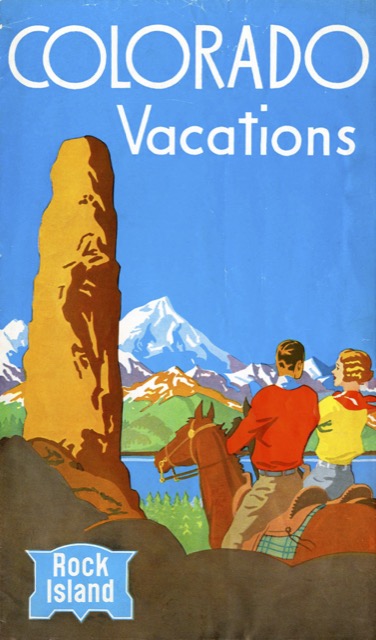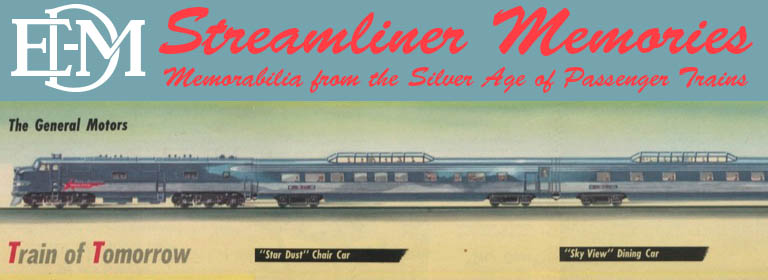Whether because of the Depression or because Rock Island marketers wanted to simplify the printing process, this is a brochure rather than a booklet. Though that means less space–approximately the equivalent of 12 pages of the Under the Turquoise Sky booklets–it also means that multiple colors could be used on every panel at little extra cost.
 Click image to download a 6.7-MB PDF of this brochure.
Click image to download a 6.7-MB PDF of this brochure.
The fourteen photographs, many of which were used in previous Under the Turquoise Sky booklets, are still in black and white. However, these photos are supplemented by many color illustrations showing people horseback riding, hiking, fishing, camping, golfing, and other recreational activities. Similar color graphics show the interiors of the Rocky Mountain Limited or another Rock Island train. The use of bright, primary colors rather than the dull colors often found in lithographs accompanying railroad ads of the era underscores the theme that Colorado is a bright, exciting place.

This is a surprisingly modern looking brochure for 1935. The B&W photos don’t help it (especially the one of no one enjoying themselves in the diner) but all those primary colors do help add interest. This brochure showed the real reason for the decline of the passenger train. It wasn’t just airplanes, it was auto air conditioning. As the brochure points out, who wants to drive their car over the sultry prairies and plains, spending muscle cramped days, and hot, sleepless nights? You could enjoy an air conditioned train instead, and keep all that energy you got from breathing in all that ozone up in the mountains. The widespread availability of vehicle A/C and air conditioned motels by the late 50’s killed that appeal on the train. Now it just took longer, and you had to put up with aging equipment breaking down, which delayed you even more.
The verbiage about Englewood station is hilarious in 2017. I don’t think anyone would think it was an advantage today to arrive “in the heart of the South Side residential neighborhoods”. Englewood was built in 1898. It was a very small station building in the center of three long covered platforms. It was a union station in the sense that more than one railroad used it, but not how we normally think of as “Union Stations”. I was first there in 1965, and it looked every bit of it’s 67 years and more. The Chicago pollution had turned everything on the station and platforms a uniform shade of dark gray. You couldn’t tell anything on the station had ever been painted. Even then, the neighborhood looked pretty sketchy. There were two police officer on duty, and they looked like they were ready for trouble. The station is long gone now. I think it was torn down in the 70’s or maybe it just fell over one day. The last time I drove through was 2003, trying to find the site of Englewood. I was glad to have my two friends, Smith and Wesson, with me.
Regards, Jim